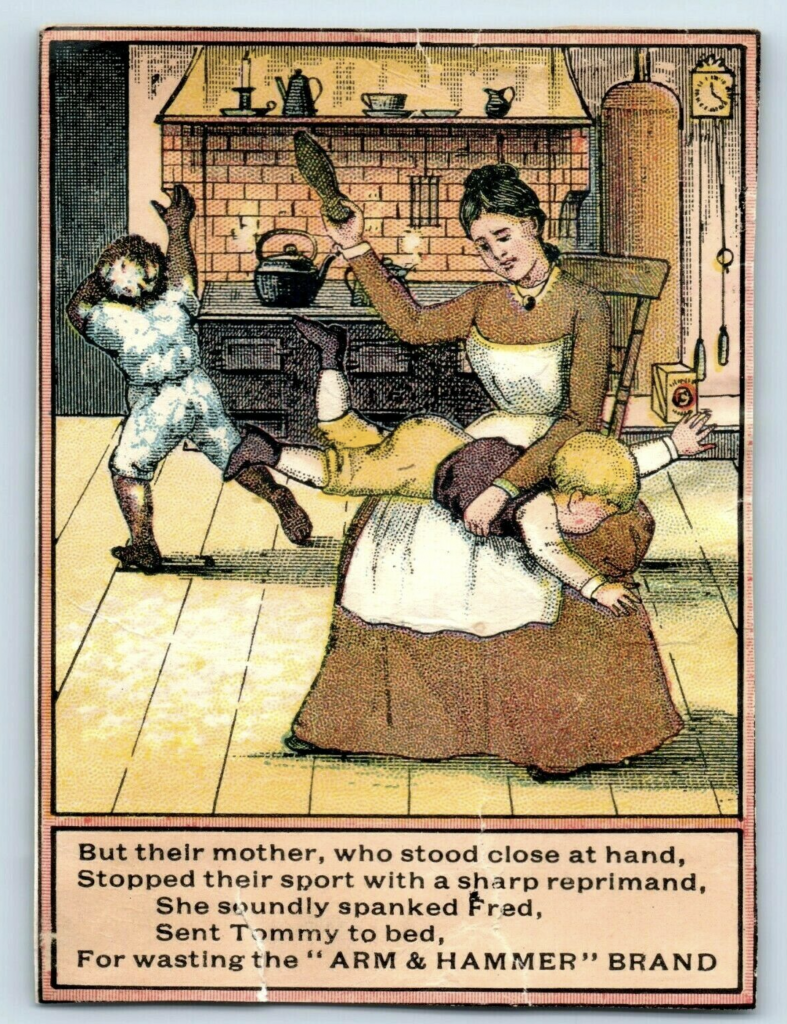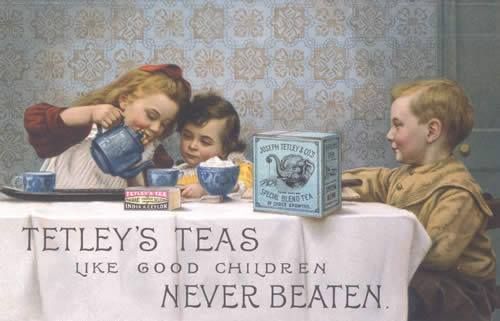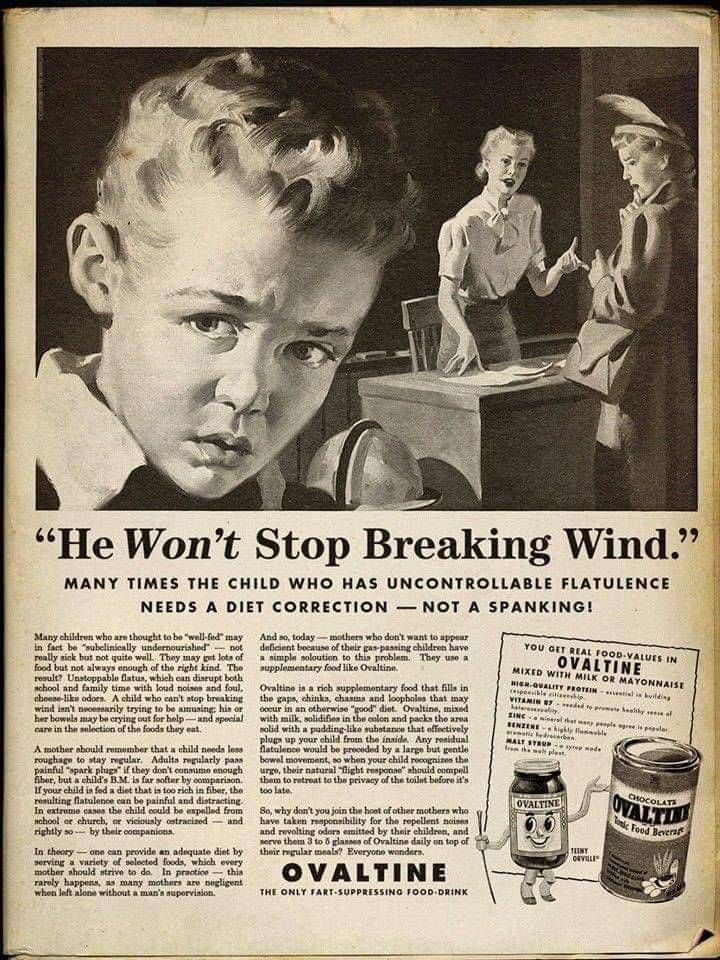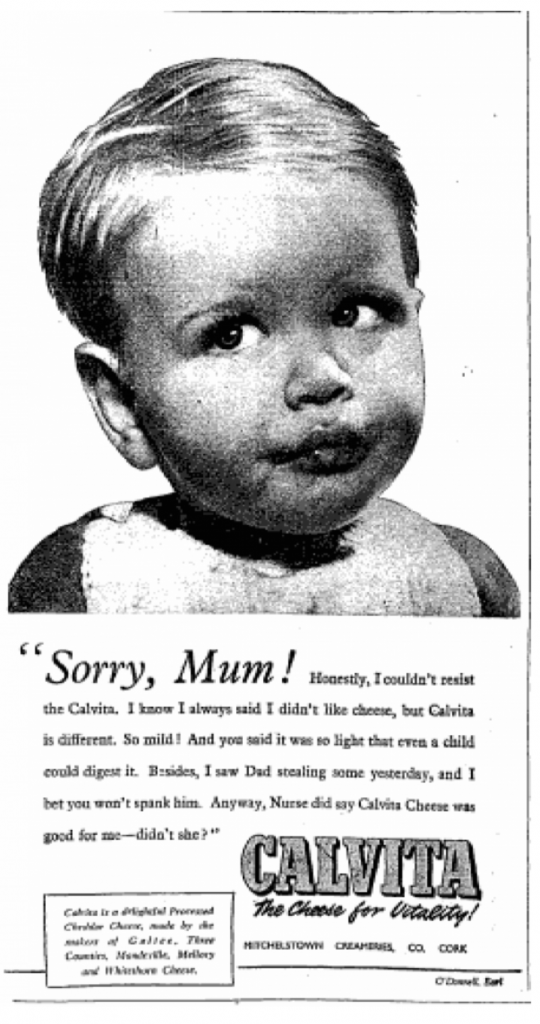Maman special report
One of the oldest and immutable principles of advertising has been to identify with your target audience, and reflect their daily lives in your imagery and copy. So, over the many years when it was the unchallenged and acceptable norm, it’s not surprising that the spanking of the household’s children was one of those touchstones surprisingly frequently employed by advertisers.
One of the earliest forms of advertising to reflect this everyday feature of family life were trade cards. These were really an early form of the business card, but instead representing an individual, they were handed out in large quantities to make their recipients aware of a particular business. One side would carry an eye-catching or amusing message, the other would have the business’s address, sometimes accompanied by a price list, sometimes by a map of how to find it.
Here is a fairly early example from a tailor called Nicoll in Chicago. It’s based on the familiar nursery rhyme of Jack and Jill, of which there are many variants. However, few of them mention the children being subsequently spanked, and indeed in the only reference I could find myself, it’s Jill who is on the receiving end, not Jack. However, in this trade card, Mother is busy with the strap on Jack’s behind – not sure what exactly it has to do with tailoring!

Indeed, our next trade card illustration would seem to be a better fit for Mr Nicoll. The child across his mother’s knee here has a definite problem with his seat, in more ways than one…

Note an early appearance here for one of the spanking mother’s most favoured implements, the good old slipper – although given the fact she is fully shod suggests maybe this has been borrowed from father?
For children brought up with corporal punishment in the home, as many stories on this website attest, spanking often played a prominent part in homely roleplay, and this is something reflected in several trade cards, including this one. Not sure whether the slipper is a giant one, or whether it reflects how large it seems to the children and their bottoms!

Dunlap & Co appear to have been hat manufacturers based in New York, so apart from the ‘novelty’ value, it’s difficult to see what relevance the illustrations has to their business. That would not, of course, been the case if the originator had been the Dunlop company, whose range of slippers chastised many generations of young bums! Most of the businesses behind these trade cards are long gone, but here is one example of a brand still going strong…

Once again, note the presence of the maternal slipper. Also, not a bare bottom in sight. Although taking a child’s pants and underwear down prior to a spanking was common practice, presumably the sight of naked buttocks was presumably considered too risqué for general circulation. Here’s a trade card which made me look twice but, on balance, I don’t think mother has adjusted his clothing…

Talking of trade cards, here’s an image that may already be familiar to many spankos, having been reproduced in books such as Edward Anthony’s Thy Rod and Staff and Ian Gibson’s The English Vice. It uses a bit of clever punning…

The ‘base burner’ was a type of stove, manufactured by the Co-Operative Foundry Co of Rochester, NY, but here mother (or maybe it’s nanny?) is picture employing a ‘base burner’ of a different sort, designed to heat up small bottoms! One wonders whether the child covered in jam(?) will be next to go over the knee. X marks the spot indeed!
One does have to wonder whether the Co-Operative Foundry Co also had the business nouse to manufacturer real versions of that spanking stick and give them away to harassed parents. Branding on objects either indirectly associated with corporal punishment (rulers, paint sticks etc), or those specifically designed for the job, is again quite a common thread in early advertising, even persisting until well into the latter half of the 20th century, judging by this ruler – which puts a bit of a post-modern spin on the idea…


Presumably, phone installer Frank was well aware of parents’ propensity to reach for the ruler when junior over-reached himself! Others had no such compunction about children being given a sore bottom…

Evidently, the good folk at Deerwood Quality Foods were firm believers in ‘spare the rod and spoil the child’ – and that paddle seems to have seen a bit of action in its day!
Let’s move on to more conventional print advertising, and here we see something of a shift. Trade cards tended to portray childhood spankings as comical or at least ‘cute’, rather than the distressing experiences they undoubtedly were for the kids themselves! I suppose there is something a little forbidden or ‘naughty’ about the act of spanking itself which resonates with both children and adults. However, in mainstream advertising, spanking was portrayed rather more soberly…

Tetley are still in business as both tea producers and brewers, but I can’t see that particular strap line (pardon the pun) being resurrected any time soon!
The idea of a product preventing a spanking is one used by many advertisers, as we’ve already seen with the washable inks trade card. Here’s another brand which is still going strong in the 21st century – although its ability to prevent sore bottoms probably won’t be mentioned again any time soon (apologies for the small size, largest I could find)…

Poor old Pat! If only mother had bought a Bissell, her bottom would be out of danger by now! Pete seems a rather smug little brat, though. Wouldn’t you just love to take his pants down and give him a big surprise?
A recurring theme in advertising during the 40s, 50s and 60s is the linking of childish misbehaviour to poor health. Borden’s Hemo, a kind of milky drink with vitamins, explored this, albeit with a light-hearted touch (though I’ll be seeing that anthropomorphic cow in my nightmares)…

If that top image looks familiar, by the way, you’re not mistaken – it featured in the original Maman website’s logo.
You might think that a child who persistently farts in class is well overdue for a smacked bottom, but no – according to the folks at Ovaltine, mom and teacher should put that paddling on hold…

I don’t think suppression of wind is highlighted in any of Ovaltine’s marketing campaigns today. I actually had to have a close look at this image, because I originally couldn’t believe that the word ‘fart’ would be used openly in advertising of that period, and certainly not in the strapline. It was considered a crude word when I was a child, and myself and thousands of other children (at least in the UK) were taught to refer to this bodily function, ironically, as a ‘trump’.
However, the rest of the ad looks genuine enough so maybe there was less of a taboo around the word in the US (from where I’m guessing this image originates) at the time.
When it came to linking child discipline to bowel health, few companies were as keen as Fletchers, makers of the Castoria laxative. This is hailed as a medicine children will happily take without the threat of a sore behind hanging over them, and this motif lingered through several campaigns for Castoria, judging by the fact that the (presumably) early ones used line illustrations, whereas the later ads used posed photos…


The rather censorious overtones of the Castoria ads perhaps reflect changing attitudes to child discipline. What was once regarded as a somewhat humorous and cute feature of everyday family life (even if the reality was rather different) is now being portrayed as something to be avoided, and indeed to be ashamed of. Castoria to the rescue!
Talking of cutting the cheese, even in this more serious era there was still room for the odd bit of humour surrounding spanking, as this 1950s Irish advertisement demonstrates…

Rather an odd taste for a mischievous child, mind you. I’m also not sure how many district nurses go around these days advising young mothers to stuff their children’s faces with cheddar!
By this time, the depiction of children actually being spanked in adverts was on the decline – but not dead altogether, as this 1960s(?) image demonstrates, once more with the help of a well-worn pun…

The boy looks unusually happy to be in that position – a future reader of this website, perhaps? Maybe if those trousers were down rather than up, he’d be looking a little less confident!
Needless to say, in these sensitive times, references to spanking in advertising – at least where children are concerned – have pretty much died a death.
As I mentioned at the beginning of this piece, advertising’s aim is to reflect customers’ lives – and when the only smacking of children’s bottoms is going on firmly behind closed doors, and is mostly roundly condemned by society, it’s not surprising that it no longer has a place in the world of marketing.
